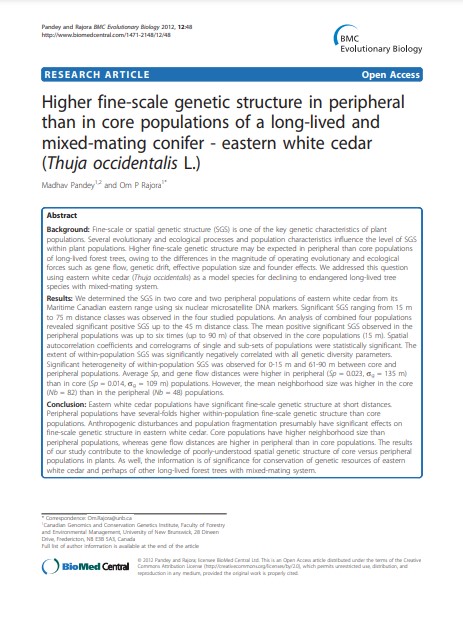Higher fine-scale genetic structure in peripheral than in core populations of a long-lived and mixed-mating conifer - eastern white cedar (Thuja occidentalis L.)
Bosque Modelo:
Nova Forest Alliance
Temática:
Conservación
Tipo de documento:
Artículo científico
Resumen
Background: Fine-scale or spatial genetic structure (SGS) is one of the key genetic characteristics of plant populations. Several evolutionary and ecological processes and population characteristics influence the level of SGS within plant populations. Higher fine-scale genetic structure may be expected in peripheral than core populations of long-lived forest trees, owing to the differences in the magnitude of operating evolutionary and ecological forces such as gene flow, genetic drift, effective population size and founder effects. We addressed this question using eastern white cedar (Thuja occidentalis) as a model species for declining to endangered long-lived tree species with mixed-mating system.
Results: We determined the SGS in two core and two peripheral populations of eastern white cedar from its Maritime Canadian eastern range using six nuclear microsatellite DNA markers. Significant SGS ranging from 15 m to 75 m distance classes was observed in the four studied populations. An analysis of combined four populations revealed significant positive SGS up to the 45 m distance class. The mean positive significant SGS observed in the peripheral populations was up to six times (up to 90 m) of that observed in the core populations (15 m). Spatial autocorrelation coefficients and correlograms of single and sub-sets of populations were statistically significant. The extent of within-population SGS was significantly negatively correlated with all genetic diversity parameters. Significant heterogeneity of within-population SGS was observed for 0-15 m and 61-90 m between core and peripheral populations. Average Sp, and gene flow distances were higher in peripheral (Sp = 0.023, sg = 135 m) than in core (Sp = 0.014, sg = 109 m) populations. However, the mean neighborhood size was higher in the core (Nb = 82) than in the peripheral (Nb = 48) populations.
Conclusion: Eastern white cedar populations have significant fine-scale genetic structure at short distances. Peripheral populations have several-folds higher within-population fine-scale genetic structure than core
populations. Anthropogenic disturbances and population fragmentation presumably have significant effects on fine-scale genetic structure in eastern white cedar. Core populations have higher neighborhood size than
peripheral populations, whereas gene flow distances are higher in peripheral than in core populations. The results of our study contribute to the knowledge of poorly-understood spatial genetic structure of core versus peripheral populations in plants. As well, the information is of significance for conservation of genetic resources of eastern white cedar and perhaps of other long-lived forest trees with mixed-mating system.
Información Bibliográfica
Autor:
Pandey, Madhav; Rajora, Om P.
Revista:
BMC EVOLUTIONARY BIOLOGY
Año:
2012
N°:
-
País :
Canadá
Páginas:
-
Volumen:
12
Idioma:
Ingles
Palabras claves
Thuja occidentalis, conifera





